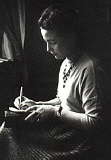MONDAY POLYTECHNIC AFTERNOON 28 January, 17.00-19.00.
Klubben in Håndverkeren, Rosenkrantzgate 7 - a discussion club for Norway's Polytechnic Society - was packed with people, invited by the ICT group and the Culture and Media group of this Society.
On the agenda: a panel of new media highly experienced persons discussing trends and challenges for multimedia editorial offices when facing "one medium traditions."
Polytechnic Society's ICT group leader Espen Andersen (an assoc prof at BI Norwegian School of Management) first introduced the afternoon's topic - Si;D, Vis;D, Web;D - by pinpointing that we will "all be working in several media" and adding to the audience of journalists and other media interested people; "I think you will all become net journalists."
Espen then outlined some key differences of writing for net-based media and paper-based newspapers and journals, e.g. in terms of a daily writing in more frequent and modular ways etc.
He then delineated three trends in this transition towards more netbased practices and I'll try to summarize according to my own quick notes:
1. Putting together different ways, information becomes lego pieces.
2. Starting to link into the text, also f.ex. links to competitors if interesting for the reader (even to another local newspaper).
3. Using alternative interfaces, for example, the perception of a main entrance into a site will be challenged because most people now tend to use search engines thus entering into the site through a multitude of ways.
See more thoughts from Espen Andersen here:
http://www.espen.com/Later, when editing this... I see his introduction as well as the whole panel discussion are video-recorded and thus available via his blog. So I just mention who participated.
The panelists were the following:
Torry Pedersen, responsible editor, VG nett
Petter Merok, Microsoft's local technology director.
Eirik Newth, author and independent blogger
Eirik Solheim, media developer and project manager at NRK.
I just like to mention that Solheim organized his talk around three points; Quality, Social interaction ("Alt dette sosiale"), and "NRK before and now." Eirik pinpointed that "for the first time in history, people are sitting at home producing with better quality than we can in NRK." Furthermore, Eirik Solheim and also Erik Newth referred to the great potentiality of opening up NRK's archives.
See more on Eirik's activities and experiences from
http://eirikso.com/--------------------
Own reflection: By the way, I just bought a collection of DVD's "100 år med historie (hundred years with history) 1900-1999," a documentary edited by Gary Tarpinian based on archives material from both BBC and Pathe. I've explored one of the DVD's, 1940-1949, as a way to learn key events in history together with my 18 year old son. We both agreed it was useful ...but we also need to remember the material from the 2nd WW is coloured by one side, as my son said.)
Anyway, I really hope NRK will explore this potentiality of its rich archives without not necessarily merely "selling DVDs" but indeed consider opening up its archives at least to some extent for free.
Why? There seems to be a need for differentiating and recreating what a publicly organized and funded national broadcasting media house can and should offer. This may be a good opportunity to contributing to this nation's culture and learning processes.
 Arne Dørumsgaard with a family cat
Arne Dørumsgaard with a family cat









